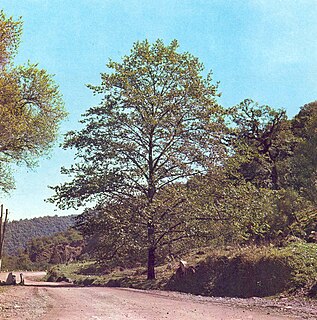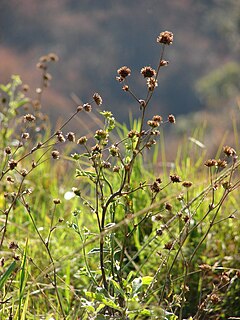
Quercus tomentella, the island oak, island live oak, or Channel Island oak, is an oak in the section Protobalanus. It is native to six islands: five of the Channel Islands of California and Guadalupe Island, part of the State of Baja California.

Boswellia is a genus of trees in the order Sapindales, known for its fragrant resin. The biblical incense frankincense is an extract from the resin of the tree Boswellia sacra, and is now produced also from B. frereana.

Cupressus lusitanica, ; cedro blanco means white cedar and is also known as Mexican white cedar or cedar-of-Goa, is a species of cypress native to Mexico and Central America. It has also been introduced to Belize, Costa Rica and Nicaragua, growing at 1,200–3,000 metres (3,900–9,800 ft) altitude.

Bursera is a genus with about 100 described species of flowering shrubs and trees varying in size up to 25 m (82 ft) high. It is the type genus for Burseraceae. The trees are native to the Americas, from the southern United States south through to northern Argentina, in tropical and warm temperate forest habitats. It is named after the 17th-century Danish botanist Joachim Burser.

Nothofagus betuloides, Magellan's beech or guindo, is a tree native to southern Patagonia.

Protea welwitschii is a species of shrub or small tree which belongs to the genus Protea, and which occurs in bushveld and different types of grassland.

Alnus acuminata is a species of deciduous tree in the Betulaceae family. It is found in montane forests from central Mexico to Argentina.

Bursera microphylla is a North American species of tree in the frankincense family in the soapwood order. Bursera microphylla, known by the common name elephant tree in English or 'torote' in Spanish, is a tree in genus Bursera. It grows into a distinctive sculptural form, with a thickened, water-storing or caudiciform trunk. It is found in the southwestern United States and northwestern Mexico.

Bursera glabrifolia is a species of tree native to central Mexico.

Bursera fagaroides is a species of flowering plant in the genus Bursera known by the common names torchwood copal and fragrant bursera. It is widespread across much of Mexico from Sonora to Oaxaca, and its range extends just into Arizona in the United States, although some sources suggest that it may now be extirpated in Arizona.

Tabernaemontana pandacaqui, known as windmill bush and banana bush, is a species of plant in the dogbane family Apocynaceae.

Zea luxurians is a species of flowering plant in the family Poaceae. It is a true grass and a teosinte. It is native to Guatemala, Honduras and Mexico, but it can also be found in areas where it has been introduced, including Brazil, Colombia, and French Guiana. It is referred to by the common names Maíz de Monte, Florida teosinte and Guatemalan teosinte.

Elephantopus mollis, common names tobacco weed, and soft elephantsfoot, is a tropical species of flowering plant in the sunflower family.

Bursera bipinnata is a Mesoamerican species of trees widespread across Mexico and Central America from Chihuahua to Honduras.
Bursera grandifolia is a Mexican species of trees in the frankincense family in the soapwood order. It is widespread across much of Mexico from Sonora to the Yucatán Peninsula, and found also in Central America as far south as Costa Rica.
Bursera lancifolia is a Mexican species of trees in the frankincense family in the soapwood order. It is widespread in western Mexico from Sonora to Oaxaca.

Hauya elegans is a species of flowering plant in the Onagraceae family. It is native to Oaxaca and Chiapas, Mexico to Honduras, Costa Rica, and Guatemala.

Markhamia obtusifolia is a species of plant in the family Bignoniaceae. It is found in Southern Africa.
Phaseolus pauciflorus is a species of wild bean native to Mexico and Guatemala.
Jose Cuatrecasas Medal for Excellence in Tropical Botany was initiated in 2001 by the Smithsonian National Museum of Natural History, USA. It is named after José Cuatrecasas, a pioneering botanist and taxonomist who worked on the flora of tropical South America. It is awarded annually to a scientist who has made a very significant contribution to advancing the field of tropical botany. Nominations for the award can be made by all in the Botany Department at the museum.

















